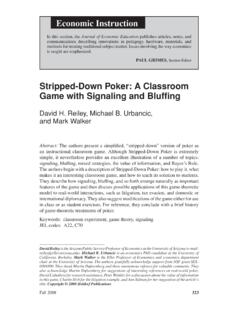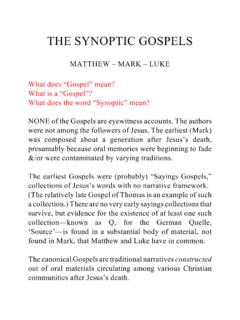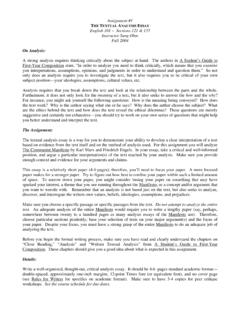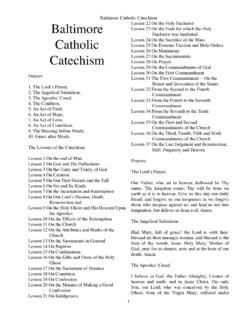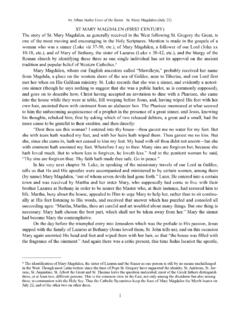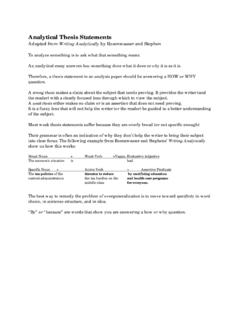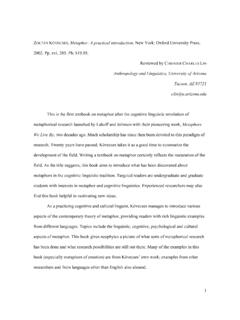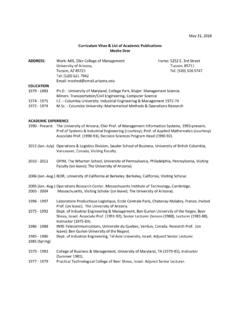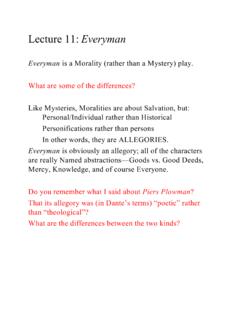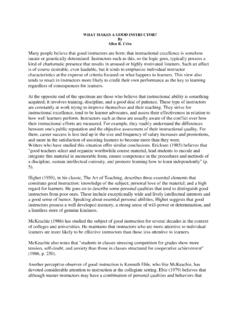Transcription of The Pure Theory of Public Expenditure Paul A. Samuelson ...
1 The Pure Theory of Public ExpenditurePaul A. SamuelsonThe Review of Economics and Statistics, Vol. 36, No. 4. (Nov., 1954), pp. URL: Review of Economics and Statisticsis currently published by The MIT use of the JSTOR archive indicates your acceptance of JSTOR's Terms and Conditions of Use, available JSTOR's Terms and Conditions of Use provides, in part, that unless you have obtainedprior permission, you may not download an entire issue of a journal or multiple copies of articles, and you may use content inthe JSTOR archive only for your personal, non-commercial contact the publisher regarding any further use of this work. Publisher contact information may be obtained copy of any part of a JSTOR transmission must contain the same copyright notice that appears on the screen or printedpage of such JSTOR Archive is a trusted digital repository providing for long-term preservation and access to leading academicjournals and scholarly literature from around the world.
2 The Archive is supported by libraries, scholarly societies, publishers,and foundations. It is an initiative of JSTOR, a not-for-profit organization with a mission to help the scholarly community takeadvantage of advances in technology. For more information regarding JSTOR, please contact Nov 11 21:45:04 2007 THE PURE Theory OF Public Expenditure Paul A. Samuelson I. Assumptions. Except for Sax, Wicksell, Lindahl, Musgrave, and Bowen, economists have rather neglected the Theory of optimal Public Expenditure , spending most of their en-ergy on the Theory of taxation. Therefore, I explicitly assume two categories of goods: ordi- nary private consumption goods (XI, ,X,) which can be parcelled out among different in- dividuals (I, 2, ,i, ,s) according to the 5 relations Xj = 2 Xii; and collective consump-1 tion goods (X,,,, .. ,X,,,) which all enjoy in common in the sense that each individual's consumption of such a good leads to no sub-traction from any other individual's consump- tion of that good, so that Xn+i = Xi+, simul- taneously for each and every ith individual and each collective consumptive good.
3 I assume no mystical collective mind that enjoys collec- tive consumption goods; instead I assume each individual has a consistent set of ordinal pref- erences with respect to his consumption of all goods (collective as well as private) which can be summarized by a regularly smooth and con- vex utility index u' = u'(Xil, .-.,Xin+,,) (any monotonic stretching of the utility index is of course also an admissible cardinal index of preference). I shall throughout follow the con- vention of writing the partial derivative of any function with respect to its jth argument by a j subscript, so that ui, = aui/aXii, etc. Pro-vided economic quantities can be divided into two groups, (I) outputs or goods which every- one always wants to maximize and (2) inputs or factors which everyone always wants to minimize, we are free to change the algebraic signs of the latter category and from then on to work only with "goods," knowing that the case of factor inputs is covered as well.
4 Hence by this convention we are sure that u', > o always. To keep production assumptions at the mini- mum level of simplicity, I assume a regularly convex and smooth production-possibility sched- ule relating totals of all outputs, private and collective; or F(XI, ..,X,,,) = o, with Fj > o and ratios Fj/Fndeterminate and sub- ject to the generalized laws of diminishing re- turns. Feasibility considerations disregarded, there is a maximal (ordinal) utility frontier repre- senting the Pareto-optimal points -of which there are an (s -1)fold infinity- with the property that from such a frontier point you can make one person better off only by making some other person worse off. If we wish to make nor- mative judgments concerning the relative ethical desirability of different configurations involv- ing some individuals being on a higher level of indifference and some on a lower, we must be presented with a set of ordinal interpersonal norms or with a social welfare function repre- senting a consistent set of ethical preferences among all the possible states of the system.
5 It is not a "scientific" task of the economist to "deduce" the form of this function; this can have as many forms as there are possible ethi- cal views; for the present purpose, the only restriction placed on the social welfare func- tion is that it shall always increase or decrease when any one persoil's ordinal preference in- creases or decreases, all others staying on their same indifference levels: mathematically, we narrow it to the class that any one of its in- dexes can be written U = CT(ZL', .. ,us)with Uj > 0. 2. Optimal Conditions. In terms of these norms, there is a "best state of the world" which is defined mathematically in simple regu- lar cases by the marginal conditions U,u$ (i, q = I, ..,S; k = I, n) or (3)..el ---I U,uqlc (q = I; i = 2, .--,s; k = I). r 387 I 388 THE REVIEW OF ECONOMICS AND STATISTICS Equations (I) and (3) are essentially those given in the chapter on welfare economics in my Foundations of Economic Analysis.
6 They constitute my version of the "new welfare eco- nomics." Alone (I) represents that subset of relations which defines the Pareto-optimal utility frontier and which by itself represents what I regard as the unnecessarily narrow ver- sion of what once was called the "new welfare economics." The new element added here is the set (2), which constitutes a pure Theory of government Expenditure on collective consumption goods. By themselves (I ) and (2 ) define the (s -I)-fold infinity of utility frontier points; only when a set of interpersonal normative condi- tions equivalent to (3) is supplied are we able to define an unambiguously "best" state. Since formulating the conditions (2 ) some years ago, I have learned from the published and unpublished writings of Richard Musgrave that their essential logic is contained in the "voluntary-exchange" theories of Public finance of the Sax-Wicksell-Lindahl-Musgrave type, and I have also noted Howard Bowen7s inde- pendent discovery of them in Bowen's writings of a decade ago.
7 A graphical interpretation of these conditions in terms of vertical rather than horizontal addition of different individuals7 marginal-rate-of-substitution schedules can be given; but what I must emphasize is that there is a different such schedule for each individual at each of the (s -1)fold infinity of different distributions of relative welfare along the util- ity frontier. 3. Impossibility of decentralized sponta-neous solution. So much for the involved op- timizing equations that an omniscient cal-culating machine could theoretically solve if fed the postulated functions. No such machine now exists. But it is well known that an "analogue calculating machine" can be pro-vided by competitive market pricing , (a) so long as the production functions satisfy the neoclassical assumptions of constant returns to scale and generalized diminishing returns and (b) so long as the individuals7 indifference contours have regular convexity and, we may add, (c) so long as all goods are private.
8 We can then insert between the right- and left- hand sides of (I) the equality with uniform market prices pj/p, and adjoin the budget equations for each individual where Li is a lump-sum tax for each individual so selected in algebraic value as to lead to the "best" state of the world. Now note, if there were no collective consumption goods, then (I) and (I)' can have their solution enormously simplified. Why? Because on the one hand perfect competition among productive enter-prises would ensure that goods are produced at minimum costs and are sold at proper marginal costs, with all factors receiving their proper marginal productivities; and on the other hand, each individual, in seeking as a competitive buyer to get to the highest level of indifference subject to given prices and tax, would be led as if by an Invisible Hand to the grand solution of the social maximum position. Of course the institutional framework of competition would have to be maintained, and political decision- making would still be necessary, but of a computationally minimum type!
9 Namely, alge- braic taxes and transfers (L1, .. L" would have to be varied until society is swung to the ethical observer's optimum. The servant of the ethical observer would not have to make explicit decisions about each person's detailed consumption and work; he need only decide about generalized purchasing power, knowing that each person can be counted on to allocate it optimally. In terms of communication Theory and game terminology, each person is moti- vated to do the signalling of his tastes needed to define and reach the attainable-bliss point. Now all of the above remains valid even if collective consumption is not zero but is instead explicitly set at its optimum values as de-termined by (I), (2), and (3). However no decentralized pricing system can serve to de- termine optimally these levels of collective con- sumption. Other kinds of "voting" or "signal- ling" would have to be tried. But, and tWis the point sensed by Wicksell but perhaps not fully appreciated by Lindahl, now it is in the selfish interest of each person to give false signals, to pretend to have less interest in a given collective consumption activity than he THE PURE Theory OF really has, etc.)
10 I must emphasize this: taxing according to a benefit Theory of taxation can not at all solve the computational problem in the decentralized manner possible for the first category of "private" goods to which the ordinary market pricing applies and which do not have the "external effects" basic to the very notion of collective consumption goods. Of course, utopian voting and signalling schemes can be imagined. ("Scandinavian con-sensus," Kant's "categorical imperative," and other devices meaningful only under conditions of "symmetry," etc.) The failure of market catallactics in no way denies the following truth: given sufficient knowledge the optimal decisions can always be found by scanning over all the attainable states of the world and select- ing the one which according to the postulated ethical welfare function is best. The solution "exists"; the problem is how to "find" it. One could imagine every person in the com- munity being indoctrinated to behave like a "parametric decentralized bureaucrat" who reveals his preferences by signalling in response to price parameters or Lagrangean multipliers, to questionnaires, or to other devices.
